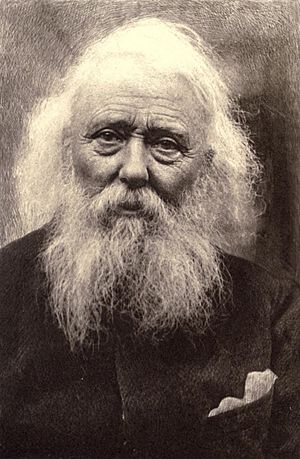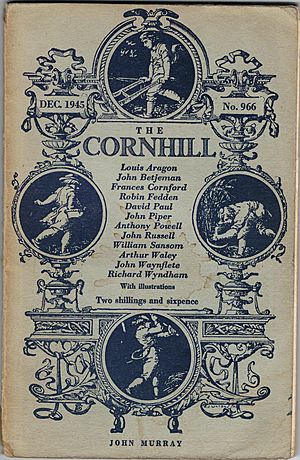William James Linton facts for kids
William James Linton (born December 7, 1812, died December 29, 1897) was a talented artist and writer. He was born in England but later moved to America. Linton was known for his amazing wood engravings, his landscape paintings, and his work as a political activist. He also wrote many books, poems, and stories.
Contents
Early Life and Learning
William James Linton was born in Mile End, a part of east London. When he was about six years old, his family moved to Stratford, which is in Essex. Young Linton went to Chigwell Grammar School. This school was founded in the early 1600s and was attended by many sons of middle-class families from Essex and London.
Starting His Career
When Linton was 15, he began training with a wood-engraver named George Wilmot Bonner. His very first known artworks can be found in a book called Pictorial Illustrations of the Bible (1833).
From 1834 to 1836, Linton worked with William Henry Powis, who had also trained with Bonner. Sadly, Powis passed away. Linton then worked for two years for a company owned by John Thompson.
After working as a skilled engraver, Linton started a business with John Orrin Smith in 1842. Their company quickly got a job working on the Illustrated London News, a new newspaper that was just starting. The next year, Orrin Smith died. This left Linton in charge of the business, which supported two families.
Standing Up for What He Believed In
For many years, Linton cared deeply about social issues and political problems in Europe. He became very active in supporting a government system called republicanism, where citizens elect their leaders.
In 1844, he helped show that the English post office was secretly opening letters belonging to an Italian revolutionary named Giuseppe Mazzini. This led to a friendship between Linton and Mazzini. Linton became very passionate about European politics.
In 1848, he carried the first message of congratulations from English workers to the new French government. He also edited a small weekly newspaper called The Cause of the People. He wrote political poems for another paper, signing them "Spartacus."
Linton helped create the "International League" for patriots. In 1850, he started a newspaper called The Leader with George Henry Lewes and Thornton Leigh Hunt. However, this paper was not as strongly republican as Linton wanted, so he soon left it.
In the same year, he wrote articles for The Red Republican newspaper, sharing Mazzini's ideas. In 1852, he moved to a place called Brantwood. From there, he published The English Republic, first as weekly papers and then as a monthly magazine. He wanted it to be "a useful guide to republican ideas" and "a record of republican progress." Linton wrote most of this paper himself, but it never made money and was stopped in 1855.
After his paper failed, he went back to his main job of wood-engraving. In 1857, his wife passed away. The next year, he married Eliza Lynn (who later became known as Mrs. Lynn Linton) and moved back to London.
Moving to America
In 1867, Linton faced money problems and decided to move to America to find new opportunities. He separated from his wife, but they stayed in touch. He settled with his children in Appledore, Hamden, Connecticut, where he set up his own printing-press.
In Hamden, Linton wrote several books about his craft, including Practical Hints on Wood-Engraving (1879) and A History of Wood-Engraving in America (1882). He also wrote his autobiography called Memories (1895). William James Linton died in Hamden on December 29, 1897.
Linton's Lasting Impact
William James Linton was a truly gifted person. His wife believed that if he hadn't spent so much time on political ideas that didn't work out, he would have become even more famous in art and writing.
As a wood-engraver, he was one of the best. He continued the style of an earlier artist named Bewick. Linton believed in using skill and intelligence in engraving, not just simple techniques. He championed the use of both "white line" and "black line" in engravings. He thought the "white line" was a better way to express art on wood blocks printed on paper, a view shared by Ruskin.



